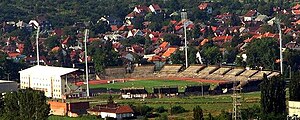Diósgyőri Stadion (1939)
| Sanctuary, Andrassy Street | |

DVTK Stadium before the new stands
|
|
| Full name | Diósgyőri VTK Sporttelep |
|---|---|
| Former names | DFC Stadium, DVTK-Borsodi Stadium |
| Location | Andrássy Street Diósgyőr |
| Coordinates | 48°5′58″N 20°43′2″E / 48.09944°N 20.71722°ECoordinates: 48°5′58″N 20°43′2″E / 48.09944°N 20.71722°E |
| Owner |
|
| Operator | Diósgyőri Sportlétesítmény Működtető Kht. |
| Capacity | 17,000 with 4,641 seats |
| Field size | 105 x 68 |
| Surface | Grass |
| Construction | |
| Broke ground | 1910 |
| Opened | 25 June 1939 |
| Renovated | 2003 (Lighting) 2006 (Main stand) 2010 (New stand) |
| Expanded | 26 May 1968 |
| Closed | 2016 |
| Demolished | 2016 |
| Construction cost | Pengő 625,000 (1939) |
| Tenants | |
| Diósgyőri VTK (1910–present) | |
Diósgyőri Stadion was a multi-purpose stadium in Miskolc, Hungary. It was the playing field of the local football association and was the home of the Diósgyőri VTK. It had a capacity of approximately 17,000.
Before the construction of Diósgyőri Stadion in 1939, the DVTK held matches outside of a local diner near the Ironworks. In 1968, the stadium underwent a major expansion and reopened on 26 May 1968 with an increased seating capacity of approximately 22,000 seats, making it the largest stadium in Hungary outside of Budapest. The record for attendance at the stadium was set on 27 November 1968, when approximately 35,000 people converged in the stadium to view the match between Diósgyőr and Ferencvárosi TC. Security concerns prompted ground management to close two sections of the stands, creating a buffer zone between the home and visiting seating, bringing DVKT Stadion's capacity to its current number.
The largest section in the complex is the western Main Stand which was built in 1939. Three other wings with a grass surface and a rekortan covered running track were built in 1968, which could hold football matches and athletic championships. The complex contains a grassed surfaced training field built in 1977, one with artificial turf and lighting built in 2006, and two others with cinder covering were opened in the 1960s. Near the stadium, there is a covered training field and a former boxing arena, which was re-opened in 2009 as a soccer field. Although the stadium does not meet the standards of many other European stadiums, it is the most modern arena in Eastern Hungary. Formal lighting was installed in the stadium and began operating on 15 November 2003.
The Main Stand underwent its first renovation in 2005 and 2006. It re-opened on 23 April 2006 after undergoing a significant modernization process, which included adding a roof and over 1,504 seats. In 2009 and 2010, the eastern wing of the 40-year-old stand was demolished. For the 100th anniversary of the club, new covered stands were built with a buffet, restrooms, and 3,137 seats on the so-called "Sunny wing" or "Napos oldal". The wing was named this because the sun made it difficult for fans to watch matches during afternoon competitions. Construction began on 10 August 2009 and an opening ceremony was held on 6 March 2010. The 2009–2010 renovation cost 400 million HUF. In 2011 and 2012, the training fields were modernized and two additional fields were built. Currently, there are four training fields with lighting, two with natural grass and another two with artificial grass.
...
Wikipedia
